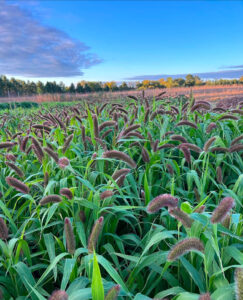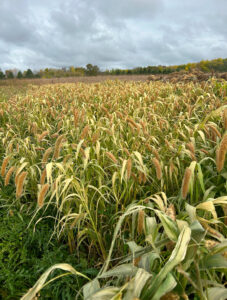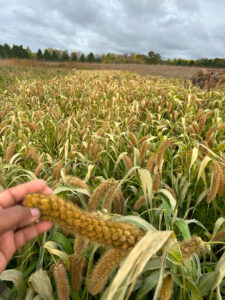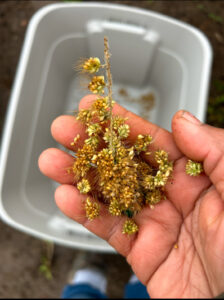Final report for FNC23-1369
Project Information
Bio: Naima Dhore Growing up Somali-American, Naima Dhore developed a deep appreciation for farming and living a life of sustainability. Naima’s story humbly began with a few potted plants in an apartment window and quickly blossomed into a full-fledged desire to create generational wealth through farmlands of her own. In 2016, Naima joined the Big River Farms incubator program in St. Croix, MN to learn the craft of farming. Having dedicated the last seven years of her life to farming, educating, and advocating for underserved communities. Naima’s target audience is all people who enjoy deliciously made, organic, and sustainably-grown food. Naima Dhore especially focuses her works within BIPOC (Black, Indigenous, and People of Color) communities throughout Minneapolis to help provide them with education, food, resources, and the support they need to feed their families. In the Somali and East African communities specifically over the years, Naima has seen a need for culturally specific foods such as millet, sorghum, etc. More recently however, Naima has seen an increased demand for millet. The millet are specific to Naima’s Somali background and this crop brings her community back to their roots. Rich, organic and nutritional millet are all part of the East African cuisine experience. Naima's goal is to continue to serves many of these communities throughout the St.Cloud and Twin City areas in Minnesota beyond the vegetables and sauces that she currently sells. After, reviewing the SARE database for other projects that are similar, there were no studies related to millet as a crop however, I did find a Japanese millet as a cover crop.
For this project, Naima will purchase the seed, plant the seed, water, weed and harvest the crop, as well as dry, process and package the seed. She will be assisted by Fagas Salah in the production components. She will write a daily journal documenting the crop progress. She will document the entire project on social media. She also will arrange for and present the cooking demonstrations and market the crop. She will reach out to others doing similar food-grade millet projects. She will present the progress and results for the Emerging Farmers conference and to other East African farmers.
There are few culturally relevant crops available to East African immigrants to Minnesota, including millet. Millet is a staple for the Somali community, for example. As the University of Minnesota Extension has investigated, seed sources are one barrier. Seed cannot be transported from country to country, and only a few companies and the US Department of Agriculture have limited millet seed availability.
Other problems include farmers’ inexperience in growing East African crops like millet in Minnesota’s environment. What pest and disease pressures does the crop face in this environment and how best should those pressures be managed?
For the past two years, Naima's Farm has worked with the University of Minnesota to grow small plots of millet, which we harvested by hand. As we scale up, can the crop be harvested and processed on-farm efficiently, using small-scale seed cleaning equipment?
A number of questions need to be explored in marketing locally grown millet for the East African community. What price point will make purchase the grain accessible while allowing for farmer profitability? Will restaurants and food co-ops be interested in purchasing millet to use in their meals?
Seed is somewhat difficult to procure and the crop will be labor-intensive, so I plan to plant 20 beds (100 feet of millet). I will be planting the foxtail and proso millet varieties . After two years of experience growing foxtail millet and conversations with the Somali community, I have decided foxtail millet and proso is the most promising variety. (Some seed will be saved from the crop for next year because of the lack of seeds, specifically the proso variety.)
Manure will be applied to the beds for fertility and will be mulched with wood chips, which we get for free from a local business. The crop will be grown organically. I am concerned about bird pressure; if we experience that, I will try reflective black tape, which has been suggested by the University of Minnesota.
I have learned from Jessica Barbosa Oliveira, a graduate student at the University of Minnesota, about harvesting and processing. She told me about several useful techniques for harvesting, including a harvest sickle that allows you to cut the millet from the bottom. Fagas will assist me with the time-intensive harvest.
We will then dry the crop for a couple of weeks, then separate the seed from the hair and clean it. I will use the Winniw Wizard machine and screen for the cleaning which was recommend by a seed company I spoke with. A big part of this project is examining the usefulness of the Winniw Wizard machine for millet processing. The machine is marketed for seed cleaning in general, so I am not sure how effective it will be for millet production.
I will purchase visible plastic bags or brown bags for packaging and labeling the millet. I need to work with University of Minnesota, Agricultural Utilization Research Institute and others on this aspect of the project to make sure I'm doing this project according to food safety standards.
For marketing, I have good contacts who will be interested in cooking demonstrations. Augsburg University community garden (in relationship with partnership with Fairview M Health) have already committed to a cooking demonstration. Others, like Afro Deli, will be interested as well.
For marketing, I'll do social media cooking demos as well. I'll market to Halal Meat grocery stores first (in St. Cloud and Minneapolis) for marketing. I will approach MHealth as well, which really wants to get culturally relevant crops. I will sell the millet at the local farmers market and compare with two other market previously stated.
This grant will examine the profitability of adding millet as a crop for Minnesota’s East African community. Objectives are:
- Demonstrate the feasibility of scaling up millet production from a small demonstration crop in 2021-22 to 10 beds (100 feet), including weed, water management and pest management
- Examine how to process millet efficiently using the Winniw Wizard on-farm seed cleaning machine
- Explore markets for the locally grown millet so that it can be sold at a profitable price point
Research
The primary goal for year one was to evaluate millet's adaptation and yield in a new climate, comparing its performance to previous test locations. This time, I incorporated cow manure into the soil, I've never amended the previous farm before planting millet. Despite a late start caused by wet and cold weather conditions, I was impressed by how quickly the millet germinated, demonstrating its resilience and potential for growth even in less-than ideal condition.
I was able to broadcast more millet than I initially expected, and the germination rate was strong. indicating promising adaptability to the soil and climate condition at the time. However, the biggest challenge was the shortened growing season window, which did not allow enough time for the millet fully mature, Despite these limitations, I managed to harvest at least 50 pounds of millet that appeared to have reached maturity. Unfortunately, due to storage constraints and the timing of my transition out of the farm, I was unable to properly dry and store the crop. The millet was still damp at harvest and without access to a cool, pest-free environment, it becomes vulnerable to mold. These post-harvest losses underscored the importance of having dedicated storage space and drying facilities, especially when working within a tight farming transition timeline. Moving forward, securing proper infrastructure for drying and storage will be a critical focus to prevent similar losses and improve overall yield preservation.
Educational & Outreach Activities
Participation summary:



 The primary goal of this project was to continue experimenting with millet, particularly in a new growing conditions, including clay soil and colder climate than I was accustomed to. My objective was to determine how much millet I could successfully produce with limited resources while documenting its adaptation, yield, and overall performance. Additionally, I aimed to assess the effectiveness of equipment such as the Wizard Winnow to evaluate potential labor savings, which is crucial for small-scale farmer like myself. Beyond the technical aspects of production, I wanted to bring attention to millet as a viable crop for small-scale farmers, highlighting its potential in niche markets and its cultural significance for man communities. By doing so, I hoped to encourage other farmers to explore alternative grains that are both sustainable and culturally relevant while also providing familiar food options for underserved communities. Throughout the project, my decision-making was guided by the need to maximize production efficiency while overcoming barriers such as limited equipment, climate challenges, and soil variability. Despite the challenges, I was able to gain valuable insights and remain committed to refining my approach to millet cultivation in the future.
The primary goal of this project was to continue experimenting with millet, particularly in a new growing conditions, including clay soil and colder climate than I was accustomed to. My objective was to determine how much millet I could successfully produce with limited resources while documenting its adaptation, yield, and overall performance. Additionally, I aimed to assess the effectiveness of equipment such as the Wizard Winnow to evaluate potential labor savings, which is crucial for small-scale farmer like myself. Beyond the technical aspects of production, I wanted to bring attention to millet as a viable crop for small-scale farmers, highlighting its potential in niche markets and its cultural significance for man communities. By doing so, I hoped to encourage other farmers to explore alternative grains that are both sustainable and culturally relevant while also providing familiar food options for underserved communities. Throughout the project, my decision-making was guided by the need to maximize production efficiency while overcoming barriers such as limited equipment, climate challenges, and soil variability. Despite the challenges, I was able to gain valuable insights and remain committed to refining my approach to millet cultivation in the future.
Learning Outcomes
I learned that as a farmer with limited resources and someone who is deeply investing in reconnecting with my roots, I was able to experiment with millet in ways I never imagined. This opportunity showed me what's possible and inspired me to dream bigger. It allowed me to further my farming journey and improving our local food system with a focus on environmental sustainability and culturally significant crops. The project demonstrated the potential for millet to benefit not just the communities that consume it but also to introduce its value to those unfamiliar with it. In addition, I hope this project inspires BIPOC farmers to explore cultural crops, which not only have unique market potential but can also transform the way we think about farming. Experimenting with millet has reinforced the importance of perseverance and creativity in farming, even when resources are limited.
This grant has expanded my exposure to new communities and generated significant interest in millet as a crop to consider in their operation. The project drew attention from both Minnesota Department of Agriculture and USDA, resulting in more farm tours and conversations about its potential. Additionally, I've had emerging farmers reach out to me, eager to learn and experiment with millet and other diverse crops. This enthusiasm has brought a sense of renewed purpose to my work and strengthened connections with fellow farmers who are also interested in exploring non-traditional crops.
Both growing seasons presented significant barriers, primarily weather, pest management and access to storage.
In the first year, I had to broadcast seeds three times due to birds eating them. A late start in the season, compounded by weather-related delays, meant that not all the millet matured on time to harvest. Additionally, at the beginning of the year, we acquired a new farm, we faced several challenges, including delays in tranistioning the millet to the new location and lack of proper storage infrastructure. Unfortunately, the millet we manage to harvest and transport was compromised due inadequate storage conditions, leading to mold issues.
In the second season, I faced similar issues. Millet failed due to gemination early on, requiring me to broadcast seeds again (about four times) in addition, flooding and poor drainage severely impacted the millet growth. Mid-season, I continued to battle weather challenges, and ultimately , I was unable to achieve a successful germination. These experiences underscored the importance of resilience and adaptability in farming.
Millet is a drought tolerant crop that performs well in dry conditions, making it an excellent option for regions facing water scarcity. It offers a sustainable and nutritious food sources, making it valuable addition to local and regional food systems. Millet struggles in short growing season, which can limit its success in certain climates. Without the proper equipment, infrastructure, and growing conditions, scaling up production can be challenging for small or beginning farmers.
Despite these challenges, I remain optimistic. With the right resources and conditions, millet has the potential to thrive and become a staple crop in areas like Minnesota. What started as curiosity has grown into a dream of cultivating millet for human consumption and effort to reconnect with my roots and learn how to incorporate crops that I am familiar with into our farm production. This process requires patience, time and persistence.
I would encourage other farmers to experiment with cultural crops like millet and seek out grants, partnerships, and community support to help navigate the challenges and awareness.